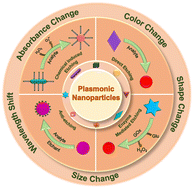Plasmonic nanoparticle etching-based optical sensors: current status and future prospects
Abstract
Plasmonic nanoparticles are an emerging tool for developing label-free multicolorimetric sensors for biosensing and chemosensing applications. The color absorbed by nanoparticles from visible light is influenced by their size, shape, orientation, and interparticle distance. Differently sized and shaped gold and silver nanoparticles exhibit a wide range of colors, aiding in the development of label-free sensors. Etching is the process of oxidizing nanoparticles, which alters their aspect ratio, shape, plasmonic peak, and outward appearance. It is typically used to create sensitive sensing platforms. Through etching, analytes could be detected in a simple, sensitive, and selective manner. The multicolor readout of nanoparticle etching-based multicolorimetric sensors can overcome the limitations of conventional colorimetric assays and improve the accuracy of visual inspection. This review discusses different approaches for target sensing using nanoparticle etching strategies like direct etching, enzyme-mediated etching, chemical reaction-driven etching, and anti-etching-based sensors and their mechanisms. In the future, etching strategies could be modified into portable sensing devices to detect a variety of analytes, which will aid in the development of on-time, in situ, and point-of-care sensing systems.

- This article is part of the themed collection: Analyst Review Articles 2023


 Please wait while we load your content...
Please wait while we load your content...